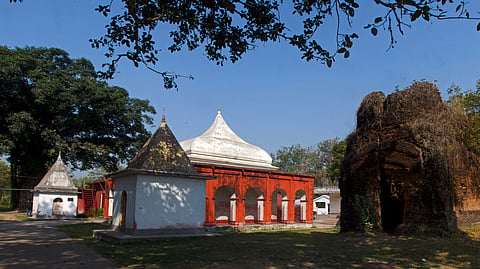
- Destinations
- Experiences
- Stay
- What's new
- Celebrating People
- Responsible Tourism
- CampaignsCampaigns
- Subscribe
- Buy Now

Kiriteswari, located just 18 km from Murshidabad in Kiritkona village, West Bengal, is a culturally rich destination that has earned national recognition. In 2023, it was honoured as the ‘Best Tourism Village of India 2023’ by the Union Ministry of Tourism—a testament to its dedication to preserving rural traditions and promoting sustainable travel.
A visit to Kiriteswari near Murshidabad offers more than just sightseeing—it’s an immersive journey into Bengal’s spiritual heritage, local traditions, and enduring devotion. For travellers seeking authenticity, history, and meaningful connections, Kiriteswari is truly a destination worth exploring.
The village is known for Kiriteswari temple, a remarkable 1,000-year-old site, is one of India's 51 Shaktipeethas, revered shrines for Shaktism worship. These sacred locations are believed to mark the places where the body parts of the goddess Sati fell, embodying deep spiritual significance. Among these is the Kiriteswari temple. The name is derived from the legend that Sati's crown (kirit) landed here, highlighting its importance in the Shakti belief system.
Though the precise date of the temple's original construction remains a mystery, local lore suggests that the main structure we see today dates back to the 19th century, with several older surrounding structures adding to its historical richness. Locals refer to the temple as Mahishamardini. And the deity is also known as Mukuteshwari. The old temple is thought to have been destroyed in 1405, and the current one was built in the 19th century by Darpanarayan, King of Lalgola. This place stands as a remarkable testament to communal harmony. The temple committee comprises members from the Muslim community who engage wholeheartedly in various Hindu rituals and cultural practices. In a spirit of generosity, the Muslims have also donated a piece of land to the Hindus, recognising the historical significance of a temple that once stood there.
The district tourism administration has established pilgrim and tourist amenities around the temple and approved 19 homestays in the village. During the months of Poush and Baisakh, the village gets many pilgrims. So does the Jagatbandhu Dham, located nearby. These temples have emerged as a pilgrimage circuit with Charbangla, Raj Rajeswari, Bhaskar Pandit, and Bhattabati Shiv temple.
The Kiriteswari Temple is a representation of architectural excellence, displaying an amalgamation of Buddhist, Muslim, and Hindu influences. The intricately crafted ‘garbha griha’ (sanctum sanctorum), where a revered black stone is honoured as the goddess, is a testament to the harmonious integration of these diverse traditions. Renowned English academic and scholar David J. McCutchion highlights the fascinating Kiriteswari Temple, a small yet captivating shrine characterised by its distinctive char-chala design. The unique architectural feature of a curved cornice has been elegantly repeated throughout the roof, showcasing eight harmonious segments. McCutchion further emphasises its charm by combining the traditional char-chala style with an inviting ek-bangla porch, making it a remarkable example of cultural heritage.
Surrounding the main temple are several structures, each telling its own story, some in various states of decay. A winding path invites you to explore a dilapidated temple ruin on the other side of the pond, which locals believe to be the remnants of the original Kiriteswari temple. The temple, perched on the opposite bank of the Bhagirathi River, is easily reachable by using a convenient ferry service, making it a must-visit destination for all.
The temple is a vibrant spiritual hub that draws in hundreds of devoted visitors. The village hosts a month-long fair during the Bengali month of 'Paush,' known as the "Paush Mela." During this event, a barter system is used to exchange handicrafts and food items for paddy. Various folk dances, including the "Baha" and "Lagre" tribal dances, are performed, preserving the unique traditions and culture of the village.
October to March are the best months to visit. Kiriteswari experiences both summer and winter in all its glory. While summers get too hot and winters too cold, the early winter months, however, stay pleasant and hence serve the best time to visit.
The nearest airport is at Kolkata (around 195 km from Murshidabad). You can avail of taxi services to Murshidabad. The nearest railway station is at Murshidabad, which is connected to Howrah, Mumbai, Chennai, Ahmedabad, and several other Indian cities. Taxi services are available from the station.
Visit The Tomb Of Siraj-ud-Daulah: Discover the poignant history of Siraj-ud-Daulah, the last independent Nawab of Bengal, whose tomb is in Khosh Bagh, Murshidabad. Executed in 1757 by Mohammad Ali Beg under an agreement involving Mir Jafar and the British East India Company, his final resting place is a testament to his legacy. Nestled in a walled compound across the Ganga River from Murshidabad, this simple, one-story mausoleum is surrounded by gardens. Within the compound lies the graves of his family members, including his mother, aunt, cousin, and grandfather. A serene mosque adds to the tranquility of the gardens, making this area a historical site and a peaceful retreat.
Jain Temples: The migration of Jains to Murshidabad during the Nawab period played a pivotal role in the establishment of numerous exquisite Jain temples in the region. Families who settled in the nearby twin towns of Azimganj and Jiyaganj became the foundation of a vibrant Jain community. Jiyaganj and Azimganj boast an impressive collection of temples, with several beautiful structures gracing both sides of the Bhagirathi river. These Indo-Mughal and colonial temples are architecturally stunning and highlight the remarkable fusion of Jain architectural styles with Muslim and European influences, making them a must-visit for anyone interested in cultural heritage. Shri Shri Neminathji Maharaj Temple, established in 1887, is considred to be the central temple. Surrounded by other beautiful Jain temples, this area offers a unique glimpse into spiritual heritage and architectural beauty.
